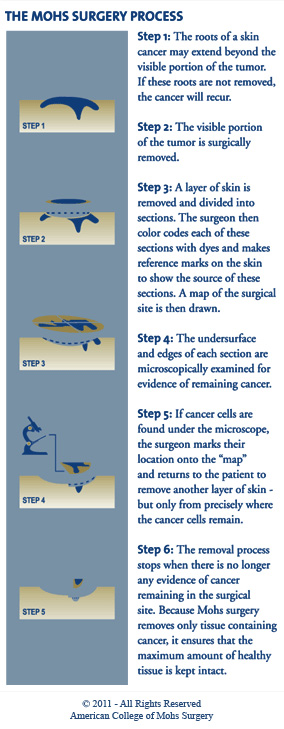Mohs Micrographic Surgery
Mohs surgery is a highly specialized technique for removing skin cancers. It was first developed in the 1930’s by Dr. Fredrick Mohs. Mohs surgery allows the skilled dermatologist to remove one layer of tissue at a time and to exam it microscopically to ensure the complete removal of the skin cancer, while preserving the maximum amount of healthy skin.
What are the advantages of Mohs surgery?
Mohs surgery offers the highest cure rate for removal of a skin cancer, 97-99% . The procedure is very safe and performed with local anesthesia. Mohs surgery allows for the tumor to be removed and examined microscopically to detect any “roots” of the cancer that can be identified and mapped. If cancer cells are seen, then an additional layer is removed, only in the areas where there is still cancer present.
How should I prepare for Mohs surgery?

- Plan to spend the day with us
- A good night’s rest followed by a light breakfast prior to surgery
- Bring a lunch (water/coffee and light snacks will be provided)
- Book, iPad, or magazine to read
- A sweater or jacket
- Someone to drive you the day of surgery (space is limited, so please only bring one friend with you and no children please)
Should I continue my medications?
- If you have been instructed to take antibiotics prior to dental procedures, please notify us to fill your prescription prior to your day of surgery. If you have artificial joint or artificial heart valves please notify us, to ensure you have the proper antibiotic prior to surgery.
- DO NOT discontinue taking Aspirin, Coumadin, Plavix or other blood thinners if these were prescribed to you by a doctor for medical reasons.
- DO discontinue taking elective use of Aspirin (non-physician directed), Ibuprofen, Advil, Aleve 14 days prior to surgery.
- Stop all herbal supplements including Vitamin E, fish oil, omega-3, gingko, ginseng, and garlic 14 days prior to surgery. These can thin your blood and cause excessive bleeding.
 What happens on the day of Mohs surgery?
What happens on the day of Mohs surgery?
Our staff member will prepare you for surgery by checking your medications and medical history and obtaining an informed consent. All of your questions will be answered prior to surgery.
Step 1: The area around you skin cancer will be anesthetized (numbed) with local anesthesia.
Step 2: Once the area is numb, the visible skin cancer will be removed and a 2-3 mm margin of normal-appearing skin is excised around the wound bed.
Step 3: The tissue is marked in mapped and color-coded. The tissue is frozen and processed in the laboratory. Your Mohs surgeon will look at the slides microscopically.
Step 4: If there are any cancer cells still present, you will be brought back the surgery room and more tissue will be taken only in the area where there is still cancer. The tissue then goes to the lab and steps 1-4 are repeated.
Once there is no more cancer detected, we will discuss closure of your wound with you.
How long does the surgery take?
Each stage can take 1-2 hours to process the tissue. It is impossible to predict how many stages your cancer will take. It generally takes 2-3 stages to clear a tumor. Plan to spend the whole day with us for your surgery.
What happens after the cancer is removed?
Once the cancer has been removed, the wound will be evaluated and we will discuss with you the most optimal closure to ensure the best cosmetic result and wound healing. This may include:
- Healing without stitches (secondary intention)
- Stitching side to side closure
- Skin flap
- Skin graft
- Referral to a subspecialist (such as a plastic surgeon or ENT physician)
What do I expect after surgery?
We will have you return 1-2 weeks after surgery for your stitches to be removed.
Swelling, bruising, minimal bleeding are common after surgery. Numbness may occur at the surgical site for up to 6 months to a year. Scarring can not be prevented at the surgery site but is minimized with the Mohs surgery technique. Minimal pain the first 1-2 days after surgery.
It is important to minimize your exercise and physical activity for the first 1-2 weeks after surgery.
Follow up after Mohs surgery?
It will be important for you to follow up with your general dermatologist for routine skin checks. Once you have had one skin cancer there is a 50% chance of developing a new skin cancer in 5 years.
For this information and more download the following;
![]() Note: These files are in PDF format. If you do not have Adobe® Reader® on your computer, you can download it for free by clicking here or on the Get Adobe Reader icon.
Note: These files are in PDF format. If you do not have Adobe® Reader® on your computer, you can download it for free by clicking here or on the Get Adobe Reader icon.
We are located at 4730 NE Stallings Drive, Nacogdoches, TX 75965.
